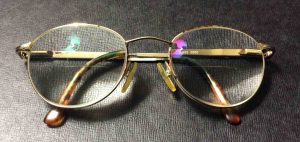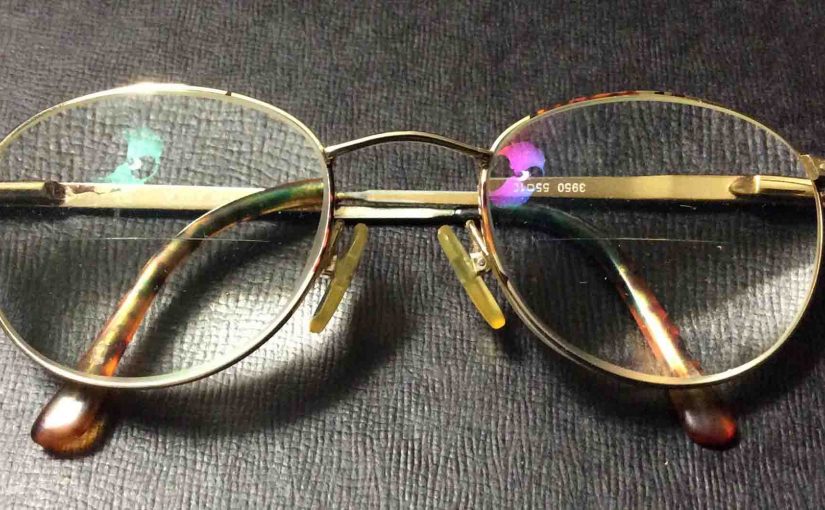Anti reflective lenses have found their way into most optical applications over the past two decades. They’ve become widely available, affordable, and notably more durable. But this coating scratches easily and is expensive to buy initially or replace. Definitely good and bad to AR coatings. So in this piece, we discuss the anti reflective glasses coating disadvantages as we learned from wearing perhaps ten pairs of AR eyeglasses through the years.
Anti Reflective Glasses Coating Disadvantages
Easily Damaged
An anti reflective coating tends to be quite thin. So it can be quite easy to rub off, scratch, or otherwise damage.
Smudges on an Anti Reflective Coating Show Up More
Fingerprints, body oils, and water can hinger the AR properties. So eyeglasses with AR coatings can show more glare when wet or oily. So clean your eyeglasses and anti reflective camera lenses often, to keep them performing well.
Too Much Cleaning Ruins The Anti Reflective Coating
But excessive cleaning of so-coated lenses can also degrade the AR ability. Thus we suggest cleaning them no more than once per day. See our How To Clean Anti Reflective Eyeglasses article, for hints and tips on keeping your specs and camera lenses in shipshape, and working like new, for years.
The Anti Reflective Glasses Coating is Costly
Lens manufactures still charge quite a bit more for AR coatings. Our last pair of specs cost an additional $80 for the coating. In fact, prices for this have steadily risen over the years in our experience; not fallen. We hope though, that eventually, that this advance in optics design would eventually appear on all eyeglasses by default, as it seems to have little or no negative impacts on actual lens performance.
Not Yet Found in Contact Lenses
Unfortunately, an anti reflective coating is are not yet available for contact lenses due to the fact that these coatings work best when applied to the outer surfaces of lenses, and contact lenses are always kept wet by eye tears while worn. This moisture, as mentioned earlier, interferes with how well said coatings work. And since contact lenses are always wet, developing an working anti reflective coating for them is challenging.
These Coatings Must Be Applied to Both Sides of Lenses
To work well, AR coatings must be applied to both sides of lenses. Particularly on the eye-side of eyeglasses lenses, where lenses are on the thicker side, eyelashes and eyebrows often touch the lenses and leave behind sebum and other skin oils. These, as noted, affect how well the coating tones down pesky glare.
Anti Reflective Coating is Not Well Suited for a Child’s Glasses
Children who wear eyeglasses from toddlerhood can destroy AR coatings quickly with how roughly they can play. So, to avoid needless replacement costs, it’s probably best not to give them glasses with this feature until they’ve shown that they value and care well for their eyeglasses.
Special Cleaning Cloths Needed for Lenses with the Anti Reflective Coating
In our experience, it’s best to use only a microfiber lens cleaning cloths to clean your AR eyeglasses. These can be had for a few dollars at most vision shops and optometrists offices. Many will give you a couple if you buy your eyeglasses from them. These lenses are too delicate to survive very many repeated dry cleanings, with rougher cloth materials such as found in clothing, facial tissues, paper towels, and napkins. So, it’s best to clean only with very soft microfiber materials, that are lint-free.

May Irritate Some People’s Eyes
Depending on the design of the AR lens, some of them actually route more light into the eye; the light that would have otherwise been reflected away by the outer surfaces. Now we have never found this to cause us eyestrain or headaches though. But for those who have, a small amount of neutral density (gray) shading can be added to anti reflective lenses, to darken them a bit, and so, compensate for this additional light into the eyes effect. We feel that the reduced halo effect light offered by the anti reflex treatments more than balances out this added light.
Added Weight
Well, these coatings are so thin, that any additional mass they impart to the lenses (milligrams at the max) is minuscule in our opinions. Not a major concern.
Anti Reflective Glasses Coating Disadvantages Wrap Up
Anti Reflective glasses coating technology is very solid and helpful many situations. But these coatings do have drawbacks that anyone looking to buy them should consider, as we’ve detailed above.
Related Posts to Anti Reflective Coating Disadvantages
References for Anti Reflective Coating Disadvantages
Revision History
- 2020-12-08: First published.
